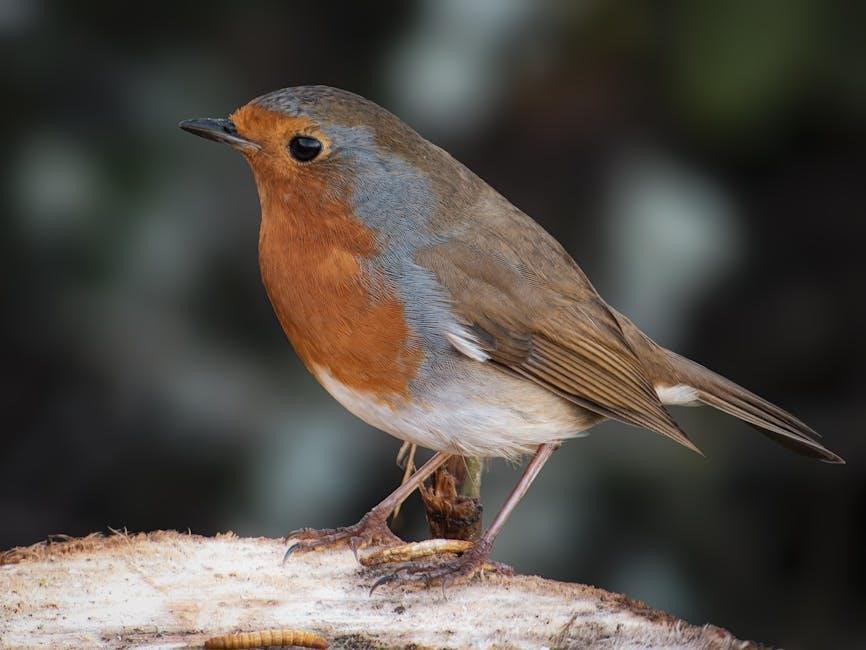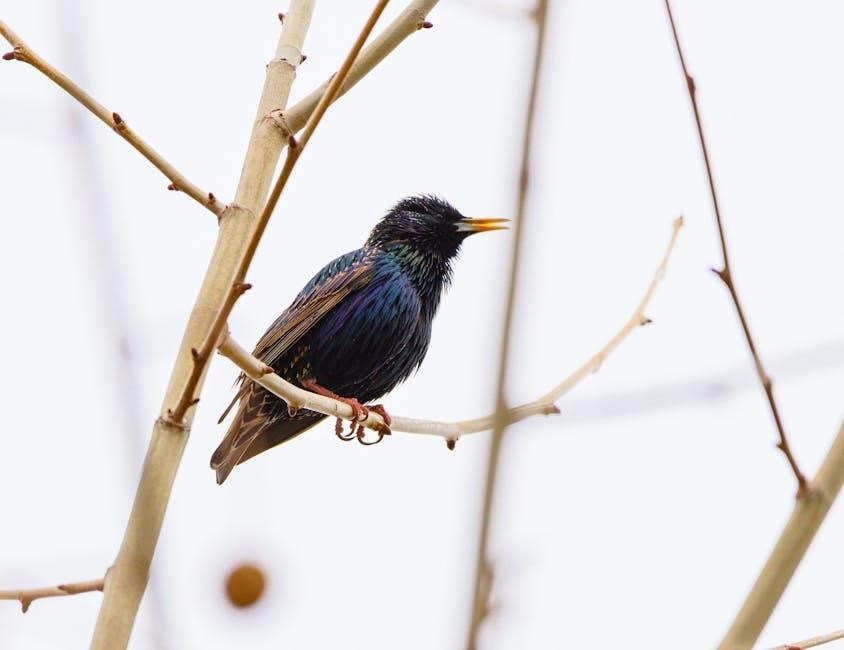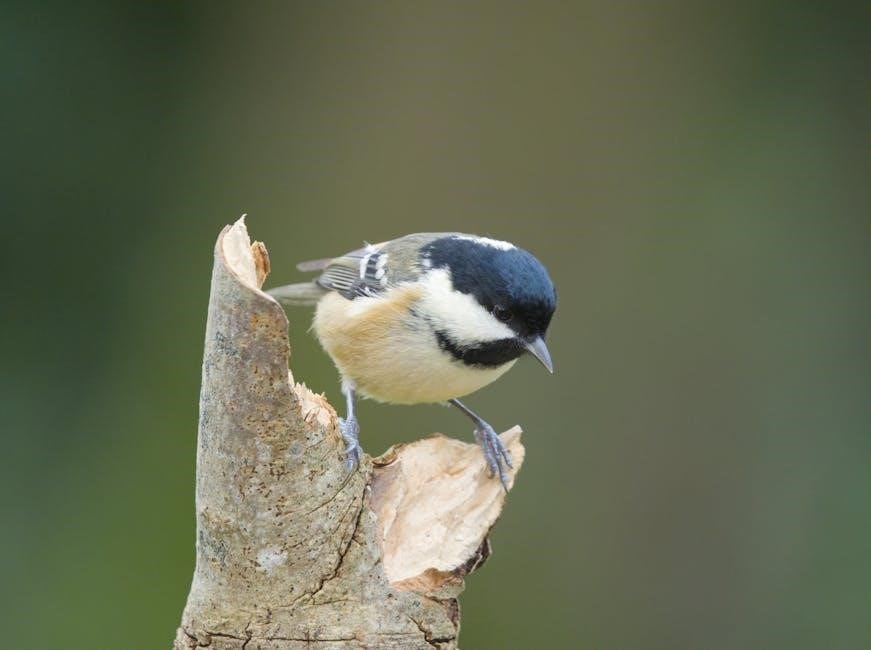Ralph Hoffmann’s guide provides detailed information on bird identification, with a focus on New England and Eastern New York, using practical field identification approach and detailed descriptions of habitats and behavior naturally.
Overview of the Guide
The Hoffmann bird guide is a comprehensive resource for bird enthusiasts, providing detailed information on various bird species.
The guide covers a wide range of topics, including bird identification, habitats, and behavior, making it an essential tool for anyone interested in ornithology.
With its focus on practical field identification, the guide enables readers to develop their skills in recognizing and understanding different bird species.
The guide’s detailed descriptions of bird behavior and habitats also provide valuable insights into the lives of these fascinating creatures.
Overall, the Hoffmann bird guide is a valuable resource for both beginners and experienced birdwatchers, offering a wealth of information and expertise to enhance their understanding and appreciation of birds.
The guide’s content is well-organized and easy to follow, making it accessible to readers of all levels.
By using the guide, readers can gain a deeper understanding of the natural world and develop a greater appreciation for the beauty and diversity of bird life.
Importance of the Guide in Bird Identification
The Hoffmann bird guide plays a crucial role in bird identification, providing readers with the necessary tools and knowledge to accurately recognize and classify different species.
The guide’s emphasis on practical field identification makes it an invaluable resource for birdwatchers, allowing them to develop their skills and confidence in identifying birds in their natural habitats.
By using the guide, readers can improve their understanding of bird characteristics, habits, and behaviors, enabling them to make more accurate identifications.
The guide’s importance extends beyond individual birders, as it also contributes to the broader field of ornithology, helping to advance our understanding of bird populations, distributions, and conservation status.
The guide’s impact is significant, as it enables readers to participate in citizen science projects, contribute to bird surveys, and inform conservation efforts.
Overall, the Hoffmann bird guide is a vital resource for anyone interested in bird identification, providing a comprehensive and authoritative framework for understanding and appreciating the diversity of bird life.

History of the Hoffmann Bird Guide
Ralph Hoffmann’s guide was first published, marking the beginning of a new era in bird identification and field guides naturally and effectively every day.
Publication and Reception
The publication of the Hoffmann Bird Guide was a significant event in the world of ornithology, with the guide being well-received by bird enthusiasts and experts alike. The guide was published by Houghton Mifflin and contained 357 pages of detailed information on bird identification. The reception of the guide was overwhelmingly positive, with many praising its practical approach to field identification; The guide’s focus on the birds of New England and Eastern New York made it a valuable resource for birders in the region. The publication of the guide marked a major milestone in the development of bird identification guides, and it remains an important work in the field of ornithology. The guide’s success can be attributed to its clear and concise writing style, making it accessible to a wide range of readers. Overall, the publication and reception of the Hoffmann Bird Guide was a significant achievement in the world of birding.
Author Ralph Hoffmann and His Contributions
Ralph Hoffmann was a renowned naturalist and ornithologist who made significant contributions to the field of bird identification. His work on the Hoffmann Bird Guide showcased his expertise and passion for birds. Hoffmann’s contributions extended beyond his writing, as he was also employed at the Santa Barbara Museum of Natural History. This position allowed him to explore and write about the birds of the Pacific coast states. Hoffmann’s intense curiosity and passion for natural history led to his exploration and writing of several books on birds. His work has had a lasting impact on the field of ornithology, and he is remembered as a pioneer in the development of practical field identification guides. Hoffmann’s legacy continues to inspire bird enthusiasts and experts alike, and his contributions to the field of ornithology remain invaluable. His work on the Hoffmann Bird Guide remains a testament to his dedication and expertise.

Key Features of the Hoffmann Bird Guide
The guide features practical field identification and detailed descriptions of bird behavior and habitats naturally every day.
Practical Field Identification Approach

The Hoffmann Bird Guide takes a unique approach to bird identification, focusing on practical field identification methods. This approach allows users to quickly and accurately identify birds in their natural habitats. The guide provides detailed descriptions of key field marks, such as plumage, beak shape, and leg color, which are essential for identifying birds. Additionally, the guide includes information on bird behavior, including migration patterns, feeding habits, and social interactions. By considering these factors, users can make informed decisions about the identity of a bird. The guide’s emphasis on practical field identification makes it an invaluable resource for birders of all levels, from beginners to experienced ornithologists. The approach is straightforward and easy to follow, allowing users to develop their skills and become more confident in their ability to identify birds. Overall, the practical field identification approach of the Hoffmann Bird Guide is a key feature that sets it apart from other bird identification guides.
Detailed Descriptions of Bird Behavior and Habitats
The Hoffmann Bird Guide provides comprehensive descriptions of bird behavior and habitats, allowing users to gain a deeper understanding of the birds they encounter. The guide includes information on the typical habitats of different bird species, including forests, grasslands, and wetlands. It also describes the social behaviors of birds, such as flocking patterns and migration routes. Additionally, the guide covers the feeding habits of birds, including the types of food they eat and how they forage for it. By considering these factors, users can better understand the complex relationships between birds and their environments. The guide’s detailed descriptions of bird behavior and habitats make it an essential resource for anyone interested in birds and their natural histories. The information is presented in a clear and concise manner, making it easy for users to access and understand. Overall, the guide’s focus on bird behavior and habitats sets it apart from other bird identification guides.

Impact of the Hoffmann Bird Guide
The guide influenced ornithological education and conservation efforts naturally and effectively every day.
Revolutionary Approach to Bird Identification
The Hoffmann Bird Guide introduced a revolutionary approach to bird identification, focusing on practical field identification and detailed descriptions of bird behavior and habitats. This approach was groundbreaking for its time, providing a new and innovative way for bird enthusiasts to identify species. The guide’s emphasis on field marks, behavior, and habitats allowed users to make more accurate identifications, and its seasonal and monthly organization made it easier to find information on specific species. The guide’s influence can still be seen in modern birding guides, which often follow a similar approach. The Hoffmann Bird Guide’s revolutionary approach has had a lasting impact on the field of ornithology, and it remains an important resource for birders and naturalists today. The guide’s innovative approach has also inspired new generations of birders and naturalists, and its influence can be seen in many areas of bird conservation and education.
Influence on Ornithological Education and Conservation
The Hoffmann Bird Guide has had a significant influence on ornithological education and conservation, inspiring new generations of birders and naturalists. The guide’s emphasis on practical field identification and detailed descriptions of bird behavior and habitats has helped to promote a greater understanding and appreciation of birds and their habitats. The guide has also played a role in promoting conservation efforts, by providing information on the habitats and behaviors of different species, and highlighting the importance of preserving and protecting these habitats. The Hoffmann Bird Club, established in 1940, is a testament to the guide’s enduring influence on ornithological education and conservation. The club’s mission to promote the study and conservation of birds in Berkshire County, Massachusetts, reflects the guide’s emphasis on education and conservation. Overall, the Hoffmann Bird Guide has had a lasting impact on the field of ornithology, and its influence can still be seen in many areas of bird conservation and education today.